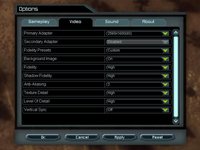Supreme Commander
Publisher: THQWe used the full retail version of Supreme Commander with the version 3220 patch applied. Supreme Commander is developed by Chris Taylor, the creator of the Total Annihilation series, and his development team, Gas Powered Games. Together, Taylor and his team have created what is widely regarded as the spiritual successor to one of the greatest RTS games of all time.
SupCom is a hugely tactical and strategic monster on a massive scale -- hundreds of units can appear on screen at once. It's a massive departure from anything else we've recently seen in the genre. It's one of (if not) the first RTS to allow the player to scroll out to view the scale of battle in its entirety.
More importantly from a graphics point of view, Supreme Commander is due for a graphical makeover when Gas Powered Games introduces DirectX 10 support later this year (this has since been cancelled - Ed.). The developers say the patch will bring a host of image quality enhancements, on top of some performance improvements -- these should definitely help in some of the more intense situations where there are literally hundreds of units on screen at any given point in time.
We used the game's in-built performance test during our testing, as this provides over seven minutes of variable gameplay -- both zoomed in and out -- that should represent typical scenarios that a user is likely to encounter whilst playing the game. Due to the massive scale of the game, it's incredibly hard to accurately quantify performance in any other way.
SupCom is pretty CPU limited in its DirectX 9 form – even at 2560x1600 4xAA 16xAF – because of the large numbers of units on screen at any one time that, when combined with a high API overhead, can introduce some significant bottlenecks. Comparing the Superclocked 8800 Ultra to Nvidia’s reference design resulted in a 7.6 percent performance increase at the highest settings we tested, which is a little lower than we were hoping for. However, when you take the CPU limitations into account, the performance increase isn’t too shabby.
Interestingly, EVGA’s Superclocked GeForce 8800 GTX was quite a bit slower than the reference GeForce 8800 Ultra, five percent in fact, which is likely a result of the slightly lower shader clocks and lesser memory bandwidth. This game doesn’t appear to be fillrate limited – an area where EVGA’s Superclocked 8800 GTX outperforms the standard Ultra – instead, the other clocks appear to have more of an effect on performance.
The BFGTech GeForce 8800 GTS 640MB OC SLI configuration was again faster than the EVGA e-GeForce 8800 Ultra Superclocked, which could potentially prove to be this card’s undoing. Finally, we’re still yet to get the Radeon HD 2900 XT CrossFire configuration running in Supreme Commander, but we’re hoping there will be a driver to fix that soon since it works just fine on a pair of Radeon X1950 XTXs. Having said that though, we’re not expecting miracles because a single HD 2900 XT is some 10 percent slower than a single BFGTech GeForce 8800 GTS 640MB OC in the best case scenario – worst case, we’re looking at over 20 percent.

MSI MPG Velox 100R Chassis Review
October 14 2021 | 15:04











Want to comment? Please log in.